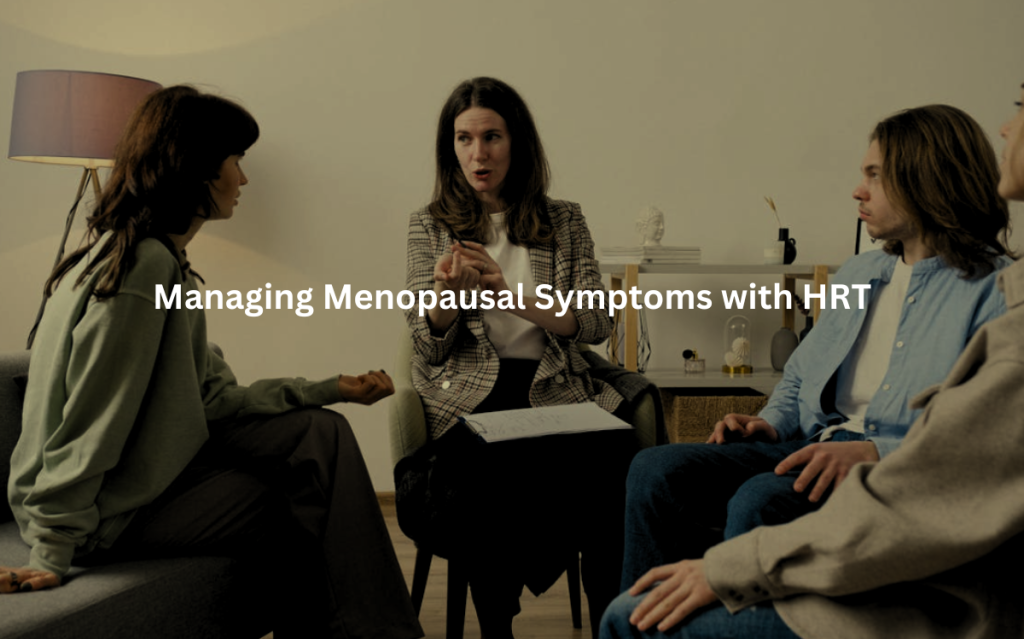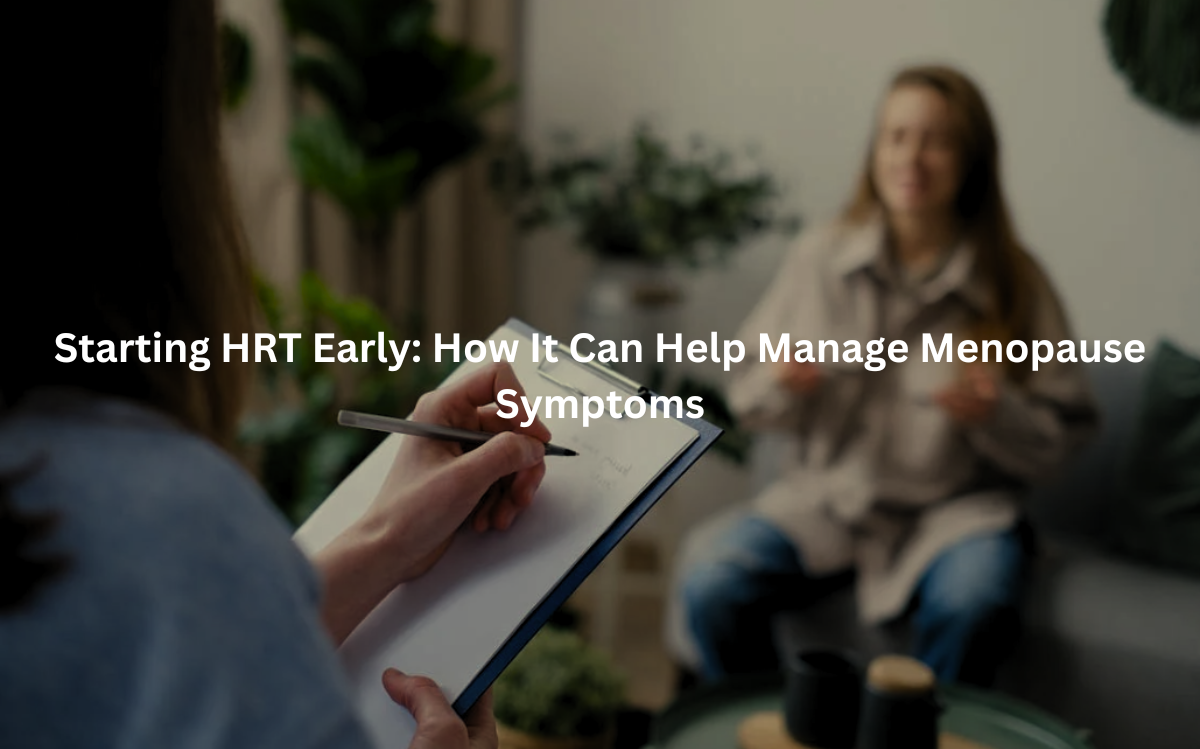Learn how starting HRT early can ease menopause symptoms and protect long-term health.
Starting Hormone Replacement Therapy (HRT) early can be a game-changer for managing menopause symptoms. By alleviating issues like hot flashes, mood swings, and vaginal dryness, HRT offers significant relief. (1)
It can also support long-term health, helping to prevent osteoporosis and cardiovascular issues. However, it’s essential to weigh the risks, such as potential blood clots and cancer, before making the decision. This guide will help you navigate the decision to start HRT early and understand its impact.
Key Takeaway
- Starting HRT early can effectively manage symptoms like hot flashes, mood swings, and vaginal dryness.
- Early use of HRT offers long-term benefits, including better bone health and reduced heart disease risk.
- Weighing risks and consulting with a healthcare provider is essential for making an informed decision.
Starting HRT Early: Key Considerations
When it comes to managing menopause, starting Hormone Replacement Therapy (HRT) early can be a game-changer for many women.
Those who begin HRT soon after their symptoms appear—often around the age of 45 or 50—might find that it offers significant relief from symptoms like hot flashes and mood swings. This early intervention may also help protect long-term health, especially bone density and cardiovascular function, both of which can decline as estrogen levels drop.
However, there are some concerns about the safety of early HRT use. One common worry is the risk of blood clots, especially in women who already have other risk factors like obesity or a family history of clotting disorders.
Breast cancer is another concern, as some studies have shown that long-term use of combined estrogen and progestogen can slightly increase the risk. The risk of ovarian cancer, although debated, is also often mentioned in discussions about HRT.
Despite these concerns, when prescribed and monitored carefully, many women find that the benefits of early HRT outweigh the risks, particularly when considering the relief it provides and the long-term health benefits it can offer.
Different Types of HRT
There are different types of HRT, and the right choice depends on individual health needs, the stage of menopause, and personal preferences.
- Estrogen-only vs. Combined HRT (Estrogen + Progestogen): Estrogen-only HRT is typically recommended for women who have had a hysterectomy, as they no longer have a uterus. However, most women who still have a uterus are given combined HRT. The progestogen in this combination helps protect the uterus from the risk of endometrial cancer, a potential risk of estrogen alone.
- Transdermal vs. Oral HRT: Transdermal HRT (delivered via patches, gels, or sprays) tends to be more effective for some women and is considered safer for those at risk of blood clots, as it avoids the liver’s processing of the hormone, which can increase clotting risks. Oral HRT, on the other hand, is absorbed through the digestive system and has a slightly higher risk of blood clots but may be easier for some women to use.
- Continuous vs. Sequential Combined HRT: Continuous combined HRT provides a steady dose of both estrogen and progestogen, which is ideal for women who are postmenopausal. Sequential HRT, on the other hand, is typically used for women who are still in perimenopause and involves a cycle of estrogen followed by a progestogen phase to regulate menstruation and protect the uterus.
Risks and Benefits of Starting HRT Early
Starting HRT early can offer significant relief from menopausal symptoms, such as hot flashes, night sweats, and mood swings. It can also improve sleep quality, reduce vaginal dryness, and provide a sense of emotional balance.
For women in their 40s and 50s, early HRT use can even protect bone density, preventing osteoporosis and fractures, and may reduce the risk of heart disease by maintaining healthy cholesterol levels and improving blood vessel function.
However, there are risks involved. Some women may experience side effects like bloating, headaches, or breast tenderness, especially in the first few months of treatment.
Long-term risks include an increased chance of blood clots, particularly with oral HRT, and a slight increase in breast cancer risk with extended use of combined HRT. (2)
That said, these risks are generally low for women who begin HRT before the age of 60 and for those who do not have other risk factors like smoking or high blood pressure.
Managing Menopausal Symptoms with HRT

For many women, HRT is a powerful tool for managing the disruptive symptoms of menopause. Hot flashes, the most common symptom, can be significantly reduced or even eliminated with the right hormone regimen.
Vaginal dryness, which can lead to painful intercourse, is also improved with estrogen therapy. For women experiencing mood swings or anxiety, the emotional stability that HRT provides can make a world of difference, helping them feel like themselves again.
Women with premature menopause (before age 40) or those who have had their ovaries removed often face more intense symptoms, as their hormone levels drop much earlier than the average. For these women, HRT can be especially beneficial in alleviating both short-term and long-term health risks.
HRT also impacts overall quality of life. Many women report better sleep, improved energy, and even a greater sense of well-being when they are properly treated. It’s clear that, when used correctly, HRT can be a game-changer in managing menopausal symptoms.
Side Effects of Starting HRT Early
Hormone replacement therapy (HRT) can feel like a lifeline for some women. But let’s face it—it’s not without side effects.
- Common, short-term issues: Think nausea, bloating, and tender breasts. Most women see these ease up within weeks as their bodies adapt.
- More serious risks: Blood clots, especially with oral HRT, can be a concern. Older women or those with risk factors might also see a slight bump in stroke risk.
- Breast cancer debates: Long-term use of combined HRT (over five years) may increase risk slightly—though studies still don’t all agree.
Here’s the thing: risks are small, but they exist. For severe discomfort, switching methods—like moving from oral pills to patches or lowering the dose—often helps.
Doctors can tailor adjustments, and honestly, it’s worth talking through options to balance relief with safety. HRT is a tool, but it’s also a work-in-progress for many women.
Health Conditions Affected by HRT
HRT can have a significant impact on overall health, particularly for women dealing with conditions like osteoporosis, heart disease, or mental health issues.
Estrogen is known to help protect bones, and early HRT use can significantly reduce the risk of osteoporosis-related fractures. In fact, studies have shown that women who start HRT early are less likely to develop fractures later in life.
For heart health, HRT can have a protective effect, especially when started soon after menopause. It helps maintain healthy cholesterol levels and improves the function of blood vessels, reducing the risk of heart disease.
However, for women who have already experienced heart problems, like a heart attack or stroke, HRT should be approached with caution, as it can increase the risk of further complications.
Mental health can also be affected by hormone changes during menopause. For women suffering from anxiety, depression, or severe mood swings, HRT can provide relief, as estrogen plays a role in regulating mood and cognitive function.
When to Consider Combined HRT
For women with a uterus, combined HRT (estrogen + progestogen) is typically recommended to protect the endometrium (lining of the uterus) from becoming too thick and increasing the risk of cancer.
The progestogen counteracts the effect of estrogen on the uterine lining. This combination therapy is especially important for women who still have their uterus.
Combined HRT can be prescribed in two ways: continuously or sequentially. Continuous HRT provides both estrogen and progestogen every day, making it suitable for postmenopausal women.
Sequential combined HRT involves taking estrogen for a period of time and adding progestogen during the second half of the cycle, which is often used for women still in perimenopause.
Healthcare providers will assess the individual’s health history, risks, and preferences to determine the best approach to HRT.
Consulting Healthcare Providers for HRT Decisions
Starting HRT is a personal decision, and it’s essential to consult a healthcare provider before taking any steps. A doctor can help assess the risks based on factors like family history, current health conditions, and the stage of menopause. For women with a history of blood clots, breast cancer, or cardiovascular disease, a more cautious approach to HRT may be needed.
Regular reviews of HRT use are essential to ensure that the treatment is working effectively and to adjust it based on symptoms, side effects, and overall health. For those with pre-existing conditions or complex symptoms, consulting with a menopause specialist is highly recommended.
Conclusion
HRT can provide relief from common menopausal symptoms such as hot flashes, mood swings, and vaginal dryness. It also helps protect long-term health, including bone density and cardiovascular health.
- Types of HRT: Estrogen-only, combined HRT, transdermal, and oral HRT all have different uses and risks. It’s important to choose the right one based on individual health needs.
- Risks: While the risks of HRT (like blood clots, breast cancer, and stroke) are relatively low, they need to be considered carefully, especially for women with other risk factors.
- Customization: HRT should always be tailored to an individual’s health history, symptoms, and preferences. Regular check-ups are crucial to ensure the treatment remains effective.
Starting HRT early can offer substantial benefits, but it requires careful consideration and ongoing monitoring to ensure it’s the right choice for each woman.
For personalized care and expert advice on HRT options, book a consultation with Modern Menopause today. Book your appointment now.
FAQ
What is the benefit of starting HRT early during menopause?
Starting HRT early, particularly before the age of 60 or within 10 years of menopause, offers significant benefits like symptom relief from hot flashes, mood swings, and night sweats.
Additionally, it helps protect against long-term health issues like osteoporosis and cardiovascular disease, which are more common as estrogen levels decline. Early intervention ensures better management of menopause symptoms and improves overall quality of life by addressing hormonal imbalances more effectively.
Does HRT increase the risk of breast cancer?
The risk of breast cancer with HRT is generally small and dose-dependent. For women with a low risk of breast cancer, using HRT for up to five years does not significantly increase the risk.
However, prolonged use of combined HRT (estrogen and progestogen) may slightly raise breast cancer risk. For those with a family history or other risk factors, alternatives to HRT or cautious use may be recommended by a healthcare provider.
Can HRT help with heart disease risk during menopause?
HRT can help reduce heart disease risk by addressing the decline in estrogen, which is protective for cardiovascular health. Transdermal estrogen, in particular, has been shown to have minimal cardiovascular risks and may be a safer option for women with an increased risk of blood clots.
However, for women with a history of heart disease, HRT is usually approached with caution, and lifestyle changes are also crucial for managing heart health during menopause.
Is HRT safe for women with a history of cancer?
For women with a history of breast cancer or other cancers, starting HRT requires careful consideration. HRT can sometimes be avoided in women with a history of estrogen-sensitive cancers.
A healthcare professional will assess the individual’s situation, and alternatives to HRT, like non-hormonal treatments or medications, may be recommended to manage symptoms without increasing cancer risks.
How long should I take HRT during menopause?
The duration of HRT depends on individual symptoms, health history, and preferences. While it’s often recommended to use HRT for symptom relief for up to five years, there is no strict limit.
Women can continue using HRT as long as it effectively manages symptoms and provides health benefits, such as preventing osteoporosis. Regular reviews with a healthcare provider are essential to adjust the treatment plan and ensure the risks remain minimal.
References
- https://pmc.ncbi.nlm.nih.gov/articles/PMC3225442/
- https://www.womens-health-concern.org/wp-content/uploads/2022/12/11-WHC-FACTSHEET-HRT-BenefitsRisks-NOV2022-B.pdf

Leave a Reply